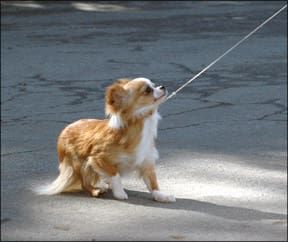It’s frustrating and embarrassing when your dog puts on the brakes and refuses to move. If he’s small you can pick him up and carry him; although that might not be the best training solution, at least it gets you out of there and you can save face. But what if it’s a Great Dane, a Newfoundland, or any breed – or combination of breeds – that’s too big to be portable? Whether your dog is giant or tiny, here are five things to do when your dog gets stuck in neutral:

288
1) Evaluate possible medical problems: Your dog may be in pain or otherwise not feeling up to par, and the last thing she wants is a jaunt around the block. If your dog refuses to move routinely, or even occasionally – not just once – it’s time for a trip to the dog doctor to look for a physical reason. You don’t want to force her to walk if she’s hurting.
2) Look for environmental aversives: Pavement gets painfully hot on warm sunny days – enough to cause considerable discomfort. Prickly weed seeds, sharp stones, sometimes even tall or wet grass can be aversive. (Dog boots can protect paws from surfaces that cause discomfort.) Maybe your dog is just hot and trying to stay in a shady spot! Be sensitive to aversive environments you can avoid; walk your dog morning and evening on very hot days. Conversely, maybe he needs a down jacket or more indoor exercise on frigidly cold winter days.
3) Consider fear issues: A temporary environmental aversive can create a negative association with the location where it occurs. Maybe your dog stepped on a bee and got stung, or a loud scary noise happened at his sticking spot. If his body language tells you he’s worried or fearful (head down, looking away, ears back, leaning back, perhaps even showing a whale eye and trembling), you’ll need to counter-condition at the place (or places) where he shows fear. (For in-depth information on counter-conditioning, see “Reducing Your Dog’s Anxieties,” WDJ April 2007.) Even better, identify specifically what causes his fear, and counter-condition that stimulus in a safer environment first, before trying it on a walk.
If he puts on the brakes as you approach the car, something about the car may be aversive. Counter-condition! Perhaps there’s a reactive dog behind a fence. If your dog gets sticky as you approach a barking, growling, berserk dog behind a fence, he may not be comfortable being barked and snarled at as you walk past. Cross the street, and then counter-condition to convince him that a snarling dog makes chicken fall from the sky, and/or arrange with your neighbors to have their dog indoors when you’re going to walk your dog.
4) Reinforce movement: If you always click and treat your dog for sitting when you stop, she may decide that stopping gets reinforced. Spend lots more time clicking for movement. If she does get stuck, avoid luring to get her unstuck, so she doesn’t learn to put the brakes on in order to get you to bring out the treats.
5) Do stuff she loves: These four tips are good for prevention and diagnosis. But what do you do in the moment, when your dog won’t move?
Do something that she loves, to get her mind off being stuck and get happy about moving. If she gets happy about targeting, play-target in a direction she is willing to move (usually back the way you came from). When she’s acting playful, target forward in the direction you want to go. Play a simple “Find it!” game, by tossing treats on the ground in the direction she’s willing to go, and then repeat the game in the other direction. Play with a ball, play tug, play any games that get her happy and moving. If it’s safe to do so, put her on a long line and run past her, fast, to the end of the line to see if she’ll chase happily after you. (Don’t use your “come” cue; do use random happy chatter).
If she gets stuck going home on walks because she’d rather stay out and have fun with you, backchain going home (start close to your front door and gradually move farther and farther away). Each time you arrive home, have a fantastic play party with her favorite toys and games so she eagerly looks forward to going home and having fun.
Pat Miller, CPDT-KA, cdbc, of Fairplay, Maryland, is WDJ’s Training Editor.






